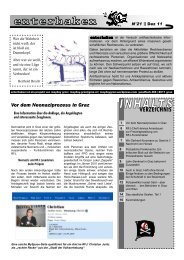Turin's CIE - International University College of Turin
Turin's CIE - International University College of Turin
Turin's CIE - International University College of Turin
You also want an ePaper? Increase the reach of your titles
YUMPU automatically turns print PDFs into web optimized ePapers that Google loves.
XII. <strong>CIE</strong>, POLITICAL ASYLUM AND INTERNATIONAL<br />
HUMANITARIAN PROTECTION<br />
“So <strong>of</strong>ten the world sits idly by, watching ethnic conflicts flare up, as if these were mere<br />
entertainment rather than human beings whose lives are being destroyed. Shouldn't the existence<br />
<strong>of</strong> even one single refugee be a cause for alarm throughout the world?”<br />
- Urkhan Alakbarov<br />
“In my country there are troubles right now. Why do they put me in this centre? My family in Libya<br />
was affected a lot by the war in Libya. My brother was burnt alive and my father was killed. I<br />
escaped from Libya because <strong>of</strong> the war and I got to Tunisia. From Tunisia I left for Italy.”<br />
- Interview 22<br />
<strong>International</strong> Law<br />
1. LEGAL FRAMEWORK: THE RIGHT TO ASYLUM<br />
As conflicts around the world have multiplied along bloody ethno-political and religious lines,<br />
governments are tasked with feeding, clothing and according rights to asylum seekers who have<br />
fled their countries <strong>of</strong> origin. At the time the 1951 Convention Relating to the Status <strong>of</strong><br />
Refugees 137 was signed in the city <strong>of</strong> Geneva, governments anticipated a speedy resolution to the<br />
“refugee crisis” 138 . However, this hope for the refugee crisis to be short-lived was both mistaken<br />
and short-sighted; the problems with adequately assisting refugees are neither new nor<br />
unusual, except perhaps in the scale at which it took place during the 20 th century 139 .<br />
Throughout the history <strong>of</strong> human civilizations, the expulsion <strong>of</strong> groups <strong>of</strong> people by other more<br />
powerful groups has been commonplace. Language, culture and religion are but some <strong>of</strong> the<br />
many factors that foster antagonism and arouse intolerance towards “the Other” and history is<br />
regrettably replete with such examples. However, the difficulty <strong>of</strong> arriving at an international<br />
consensus regarding the term “asylum” is equally understandable, given the plurality <strong>of</strong> those<br />
who could or have been called asylum seekers at different times in history.<br />
The law governing asylum seekers’ rights is broad and multi-faceted and it has been<br />
incorporated in domestic, regional and global treaties, covenants, legislation, norms and<br />
regulations. The right to seek asylum is expressed in Article 14(1) UDHR:<br />
“14(1) Everyone has the right to seek and to enjoy in other countries asylum from<br />
persecution”.<br />
Article 1(A)(2) <strong>of</strong> the Convention Relating to the Status <strong>of</strong> Refugees (as amended by the 1967<br />
Protocol) defines a refugee as:<br />
137 Convention Relating to the Status <strong>of</strong> Refugees, opened for signature 28 July 1951, 189 U.N.T.S.150 (entered<br />
into force 22 April 1954).<br />
138 Interestingly, the United Nations’ High Commissioner for Refugees was a post created with an initial period<br />
<strong>of</strong> three years, after which it was expected to cease. Ray Wilkinson, “The Refugee Convention at 50…”,<br />
Refugees: The Wall Behind which Refugees can Shelter 2(123), 2001, 2.<br />
139 The right to secure asylum is one that was recognised by the Greeks and Egyptians, and a limited<br />
understanding <strong>of</strong> the right to asylum was first codified in law by King Ethelbert <strong>of</strong> Kent in about 600 A.D.<br />
75 | P a g e















